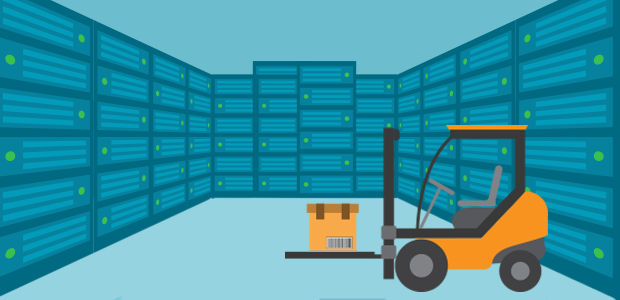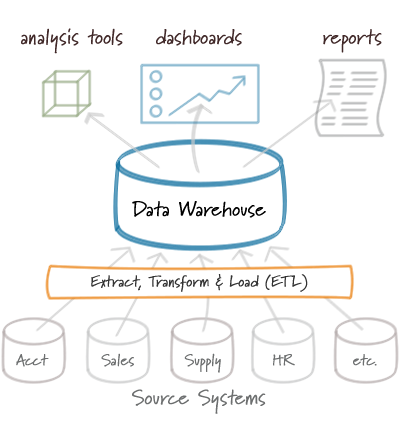The Data Warehouse for Business Intelligence
What is a Data Warehouse and why is it important for Business Intelligence?
When we hear about BI, or Business Intelligence, we also hear about Big Data and Analytics. Less often, however, do we hear about Data Warehousing.
All companies, regardless of the industry and size, find themselves having to manage increasingly large amounts of data from various sources.
Let's see why the Data Warehouse is the prerequisite that enables us to perform data analyses that will support our Business Intelligence.
What is a Data Warehouse?
The Data Warehouse is a super archive that accommodates and organizes data coming from all applications, sources, and business areas in real time.
This infrastructure aggregates all business data, of every type and nature, into a single central archive, where the information is stored and organized.

Data Warehouse and Business Intelligence
Con il proliferare di dati oggi provenienti dalle fonti più disparate, uno strumento come un Data warehouse è indispensabile.
È il pre-requisito per poter effettuare le nostre analisi dati: Data Mining, AI, Machine Learning. Tutte elaborazioni dati che hanno bisogno di poggiare necessariamente su un archivio vasto e ordinato, ovvero il nostro Data warehouse.
La Business Intelligence, gli Analytics e tutte le analisi dati hanno infatti bisogno di più dati possibili per fornire informazioni e insights di supporto alle decisioni strategiche.
Why a Data Warehouse?
But why a Data Warehouse instead of a Database, for example?
A Database (i.e., an RDBMS) stores real-time information about a specific part of your business: its main task is to process daily transactions your company makes, such as recording which items have been sold. Databases manage a huge volume of simple queries very well and quickly.
What is a Data Warehouse?
In contrast, a Data Warehouse is a system that is not updated in real time, but collects and stores a vast amount of data from many different sources with the ultimate goal of analyzing the data and producing reports.
It is therefore specialized in executing complex queries on enormous datasets.
Databases use OLTP (Online Transactional Processing) to quickly delete, insert, and update a large number of records. This type of processing responds immediately to user requests and is therefore used to process daily operations of a business in real time. For example, if a user wants to book a hotel room using an online booking form, the process is executed with OLTP.
Data Warehouses use OLAP (Online Analytical Processing) to quickly analyze huge volumes of data. This process empowers analysts to examine data from different perspectives. For instance, even if your database records sales data for every minute of every day, you may simply want to know the total amount sold each day. To do this, it is necessary to collect and sum the sales data for each day. OLAP is specifically designed to do this and uses it for data warehousing 1000 times faster than when using OLTP to perform the same calculation.
We live in a data-driven world.
Companies can no longer rely on intuition; they need to depend on accurate, updated, and integrated data. Data is often collected in isolation, and each department finds it challenging to access the data from other business functions. As a result, achieving a complete view of the company's performance becomes impossible.
The goal is ultimately to process and analyze all this data to produce insights and reports, which result from complex queries on enormous datasets (the databases collected within the company).
The Data Warehouse uses OLAP (Online Analytical Processing) tools to quickly analyze vast volumes of data.
These techniques allow analysts to examine the data for any type of analysis in extremely quick times. If we perform an analysis using OLAP tools on a Data Warehouse, it takes 1000 times less than the same analysis conducted on a Database.
Flexibility and Accessibility
The widespread adoption and development of Data Warehousing solutions over the years have made these services flexible, streamlined, and increasingly accessible to businesses.
With cloud solutions, like those offered by Digital Metrics, companies no longer need to invest in hardware or software, nor worry about maintenance and upkeep costs.
A cloud solution allows for the implementation of a Data Warehouse in very short times, without any infrastructural burden and at accessible costs.
The Value of Information Assets
The information assets of companies have become so vast over time that the companies themselves often fail to realize it.
And we are not referring only to large businesses, but also to medium-small companies that have become, in this digital age, unexpected mines of data.
Data is collected daily from the website and SEO activities, social media channels, media campaigns, retail points, warehouses, and so on.
An information asset that is often underutilized, a wealth of valuable information that remains unused or employed at the minimum of its potential.
This is precisely where the Data Warehouse can provide a solution: it enables the orderly centralization of data, which becomes intelligible and usable in a structured way.

Cloud solutions have made the adoption of Data Warehousing accessible even to medium-small enterprises that want to leverage this powerful tool for their Business Intelligence.
Discover Digital Metrics' cloud solutions to unleash the full potential of your data!

Data Warehousing Solutions for Your Business
Scopri il vero potenziale dei tuoi dati con le soluzioni flessibili e scalabili per il Data warehousing. Fai crescere il tuo Business su solide basi!
Tagged blog

